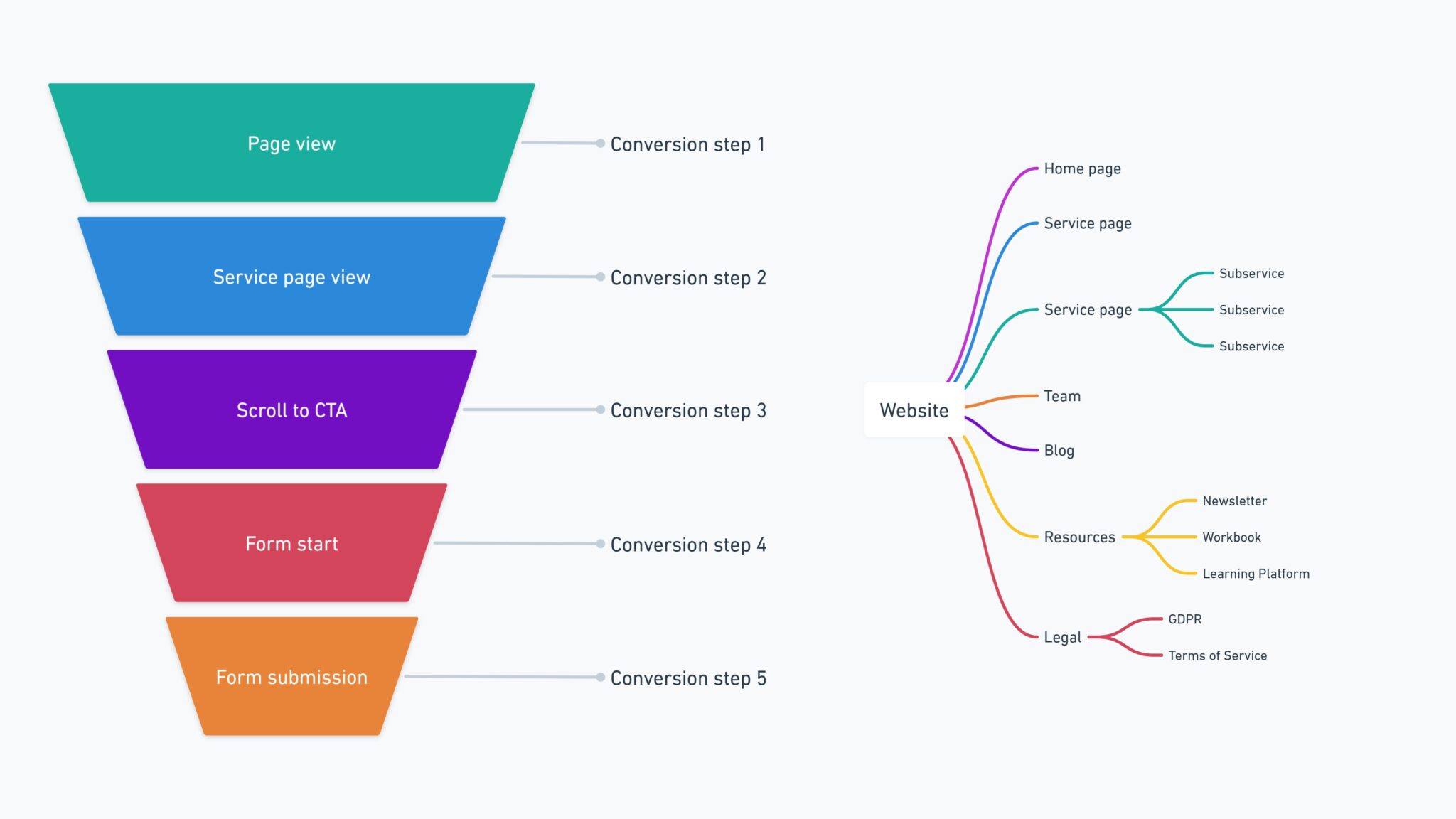
Image depicting an example of a conversion funnel and a website sitemap. Note: this example serves only to illustrate the parts of the Research & Planning step. The actual project sitemap includes more details, such as URL’s, and the conversions are defined in more detail as well.
This first step is, not surprisingly, crucial. It’s important that the project starts with a clear plan, and this can only happen after solid research has been conducted. My mission here is to understand the client and their offer (products and services) well enough to align all of the subsequent project steps with their business goals. That is not an easy task; and without proper research and planning, it becomes nearly impossible.
This step embodies several core values within the project:
- Goal-centric approach: Research & Planning ensures that every step and part of the project is designed with the end result in mind.
- Clarity: It provides clarity regarding what to include in the subsequent steps and what to potentially omit.
- Effective and efficient communication: It facilitates transparent communication, ensuring that the project stays organized and meets deadlines.
This step comprises two parts: research and planning. I’ve bundled them together because research, without its implications, doesn’t tell the whole story and holds little value when communicated to the client without a clear plan.
Research
Research involves:
- Company research
- This involves me researching my client’s company, understanding their products, services, values and goals.
- Industry, market and competitor research
- To understand the broader context of the client’s business, I must also analyze the client’s industry, niche, and their competitors. This is vital for positioning the website effectively in the marketplace, for it to be able to out-perform it’s competitors.
- Keyword research
- Keyword research includes identifying target keywords, keyword clusters and topics associated with the client’s offerings, service areas, and more. This research forms the foundation for website structure and for producing SEO-optimized content.
- SEO audit and existing website review
- In cases where the client already owns a website (most cases, really), I conduct a review, focusing on aspects like the URL structure (which may require changes for SEO reasons) and lessons learned from the previous version’s lifespan.
- Other
- Depending on project goals, additional research may be optimal or even mandatory. For instance, content keyword research for blogs, PPC keyword research for search ads, or local keyword research for local service businesses.
Planning
Planning involves:
- Content & messaging strategy session
- A meeting with the client that entails filling out my templated workbook to determine the website’s messaging. Typically, this meeting takes about an hour, but for more complex product/service structures, it may take up to 90 minutes.
- Project and communication preparation
- I set up the project in Basecamp and establish communication channels with the client. Each project step concludes with a meeting and client approval.
- Media gathering
- I collect all required media items (photos, graphics, videos, brand guidelines) necessary for the design steps. The client provides these during this initial step. If certain key media items are missing, I recommend producing them before the next step begins. However, I have managed projects where I’ve worked on UX and copy before having all media files in hand.
- Conversion definition
- Based on research findings, I define the most important parts of the website – conversions. These may include lead form submissions, purchases, quote requests, newsletter sign-ups, location searches, and more. This part is crucial as the rest of the project revolves around optimizing for these conversions. Every aspect of the website works in unison to maximize the conversion rate.
- Sitemapping
- To wrap up this step, I create a sitemap, which serves as a map of the website’s page structure with their URLs included.
With Step 1 completed, I have a crystal-clear roadmap for creating a website that aligns with my client’s business goals. I know which pages to build, the purpose of each website component, the conversions we’re prioritizing, the keywords for the copy, and the components to develop.
Now, I’m ready to kick off the actual design and development process, armed with all the advantages I need to get it right the first time. Without dedicating time to this crucial step, achieving the website’s goals would be unlikely.
